How to build an audience: my unconventional approach to rebuilding mine in a few years
In the last four years I’ve launched one 7-figure and two 6-figure businesses off the back of the audiences I’ve built up. Since a lot of the people who read my stuff don’t have an audience like mine, I often get questions, such as this one below, on how to build an audience:
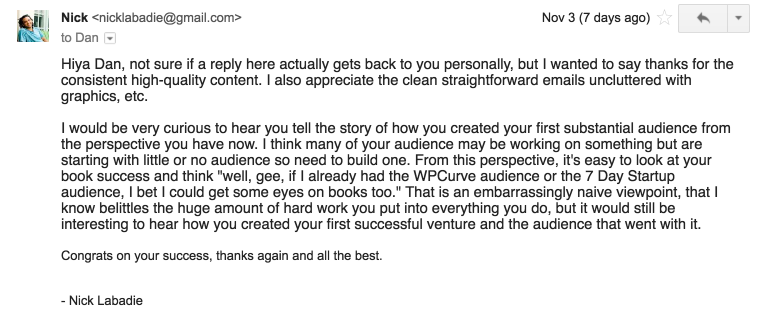
Thanks for the question Nick, because I was wondering what I was going to write about this week and I think this is a great topic.
What a lot of people don’t know, is while I’ve been online for a decade, I actually started almost entirely from scratch 4 years ago, giving up virtually everything I’d done in the 7 years prior.
There is a lot of information out there on how to build an audience, but all of it focusses on how to increase your metrics like conversions, email list subscribers, social media followers etc.
The way I went about it was a bit different, so instead of telling you how to build an audience, I’ll tell you how I specifically rebuilt mine. Maybe you can apply some of the lessons for yourself.
What happened in 2012
From my first day as an entrepreneur in June 2006, to July 2012, I ran my own web agency. In 2012 I decided to sell it and start an analytics dashboard startup called Informly. Along with the sale, I handed over almost every aspect of my online audience.
This included:
- My Twitter account which had 8,000+ followers, still more than I have today.
- My blog which had 150+ articles, and ranked #1 in Google for keywords like “Website Design”, “Web Design”, “Website Designer” and many more (I’ve never ranked for keywords like this since).
- My agency Facebook page
- My whole list of paying customers
- My Disqus blog commenting login
- All of my forum logins that I’d joined throughout the years
- All guest posts I’d ever written
- All backlinks I’d accumulated throughout the years (40,000+).
I also handed over my email list of a few thousand people, however I was able to keep a copy of that list as part of the deal, but with any paying customers removed (i.e. my most active recipients).
When I started Informly, I created all new accounts. I even shut down my personal Facebook account and created a brand new one.
What exactly is your audience?
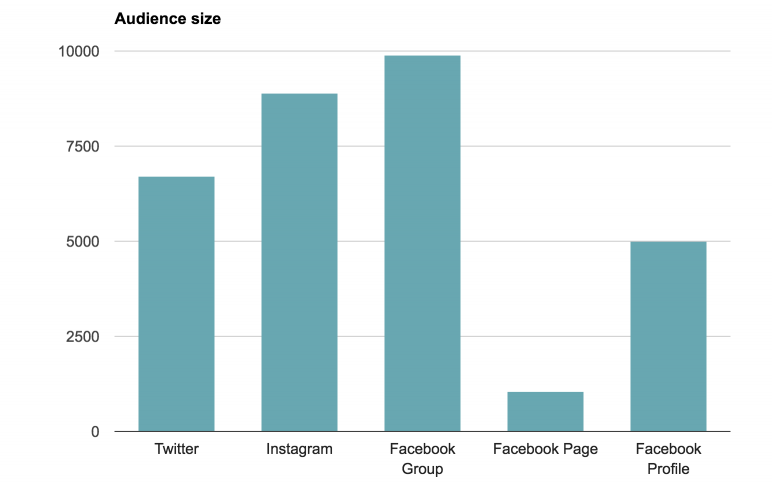
One thing I wanted to address in this post is exactly what an audience is. These days most people think of an audience in terms of the sum total of your social media followers and email list subscribers. The problem is, this doesn’t tell the whole story. In fact, it almost always tells the wrong story, particularly if you’ve been using grey hat tactics to build up those followers. Here’s my definition of an audience.
An audience is a group of people you are able to influence with your actions.
I see social media accounts all the time with hundreds of thousands of followers, that have almost no evidence that they can influence any of them. Just look at the comments on the Instagram accounts people are growing through auto-following and it’s pretty clear that their followers are dominated by accounts that are auto-liking and auto-commenting (i.e. they aren’t actually influencing real people). But because the numbers are going up, they keep doing silly things that are not helping build their audience.
An audience is not the total number of people who are listed as your followers, but the people who will see what you post and trust you enough to act on it.
So the reach is important, and with changes in social media recently, organic reach is down considerably across most platforms, particularly if your content isn’t great. But trust is also important, and trust can’t be measured by numbers.
To illustrate the first point about reach, I posted this exact message in 5 places and counted the results after about 20 hours.
I’m doing some research for a post, please like this message if you see it.
The idea was it would test the reach (i.e. who sees it) but also my ability to influence my audience (asking them to do something).
In all of these places, my following is 100% organic, I haven’t done any auto-following or auto-commenting or buying likes or any of that rubbish. I didn’t reply to the post myself until afterward so the algorithm wasn’t swayed by my involvement. Here are the results.
This chart shows the places with the most likes.
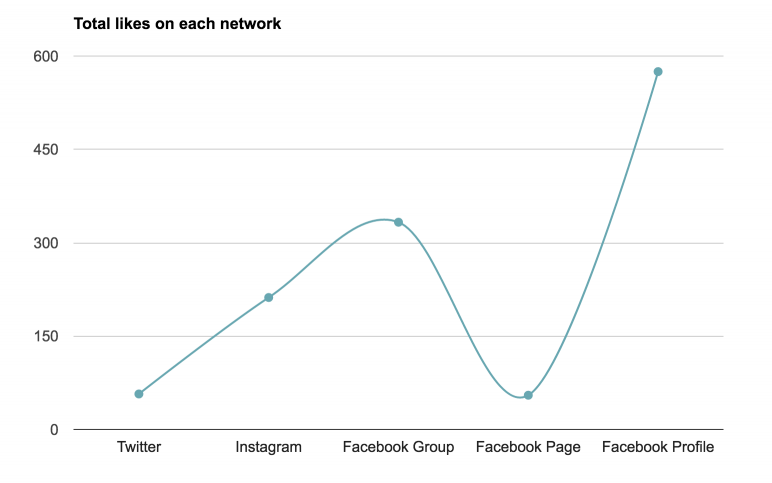
This chart shows the like percentage for each place.
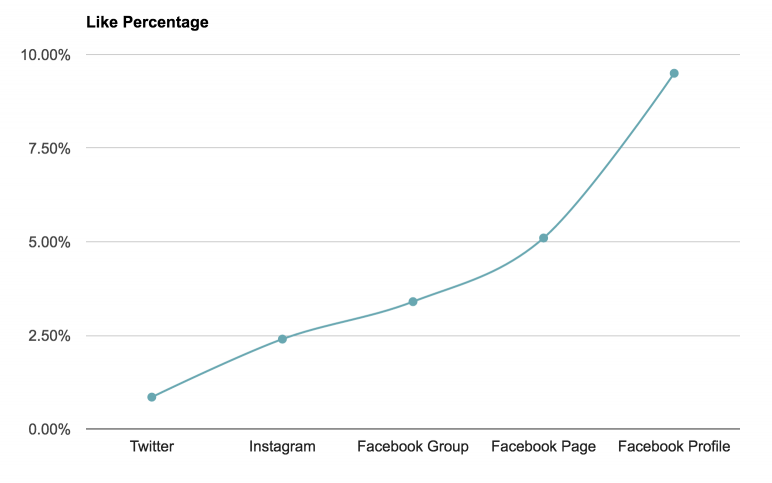
Here is the raw data with some commentary.

Interesting experiment aside, the point is it’s not the number of followers that really matters. My personal Facebook has around 5,000 friends and followers making it less than Twitter, less than my Facebook group and less than Instagram, but my ability to influence people via that channel was the highest of them all. At least part of the reason for that is I know more of them and they trust me more.
So how you define your audience is important. It feels nice to say I’ve got almost 9,000 Instagram followers, but the important thing isn’t how many followers you have but how many engaged people you have, and how engaged those people are. Those things are much harder to measure and certainly aren’t measured via vanity metrics.
It’s essential to understand this when looking at building an audience because I see people getting distracted all the time watching their vanity metrics going up, all the while they are doing the wrong things to actually build a trusted group of people who they can influence (which is the whole point).
Here are the things that I did immediately in 2012, and since, that helped me build up a group of people who trust me enough to get behind me when I launch projects.
What I didn’t do
Let’s start with what I didn’t do, because these are often the things people get distracted by and where things can go wrong.
- I didn’t use any aggressive tactics that take before you give. I never had aggressive popups on my site that pop up before users can do anything and interrupt them (*Note: I have recently added exit-intent popups, which I think are an OK compromise since they shouldn’t interrupt people).
- I didn’t engage in any activity that I thought was potentially murky. Affiliate programs are one thing that I never really felt 100% OK with so I haven’t used them. It’s cost me tens of thousands of dollars no doubt, but I think they have the potential to reduce trust and I value that highly. I wouldn’t necessarily suggest the same approach for others, but I’d be careful with not disclosing links and promoting shitty products (things I saw a lot of in the years I was building my audience).
- I didn’t use any gray hat tactics like auto-liking or auto-commenting. All this does is build an un-engaged audience which hurt your brand and distract you. I did this back in the day and learned the hard way that it doesn’t work.
- I tried not to create any bad content. A lot of people just try to make up the numbers and release a post every few days as they think ‘Google likes it’. I never took this approach and always tried to create content that was as good as I could possibly make it.
- I didn’t buy any audiences, or buy likes or anything of that nature.
- I didn’t ask too many favours. I do occasionally ask my audience for help when I launch things but I’m not the kind of guy to be constantly selling to every person I run into. It makes me feel icky and it’s not the only way to go about building an audience.
- I didn’t attack anyone else to build myself up. Again there are ways you can go about it that don’t involve you being a dickhead, and I prefer that approach.
With that said, here are some of the things I did from 2012 onwards.
I started telling my story
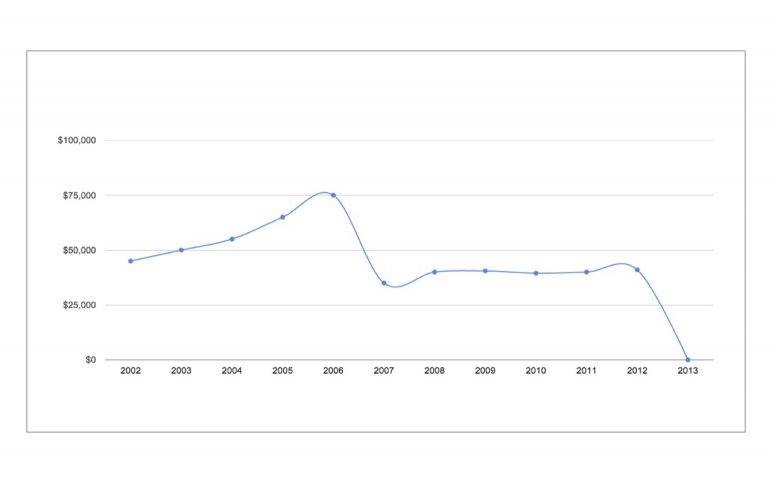
Telling my story and sharing all of my highs, as well as all of my lows, has been a big part of my journey over the past 5 years.
When I started my analytics dashboard business Informly in 2012, I decided to publish and share my monthly income reports. Back then I called them my ‘monthly reports’ on account of there being no income yet! By the time WP Curve came around and I started generating an income I was able to rebrand them as income reports.
For a lot of the time, I was told not to be as transparent and not to share income reports. People thought they drew unnecessary attention and were a bit spammy etc. But transparency is a great way to build trust and in the long run, this transparency worked in my favor.
Giving people an honest insight into my journey and thought processes has laid the groundwork for building long-term trust, the key ingredient in building an audience. Stories have universal appeal and allow others to empathize with your journey. People would often tell me they felt like I was telling a story about them, and that made me realize my story was resonating.
I’ve told my story every chance I got from media opportunities, to podcast interviews, to blog posts and 4 books – all based on a version of my story. I believe storytelling creates trust and builds an engaged audience who want to hear more.
I will write a post about storytelling soon and how to go about using storytelling in your marketing.
If one social media platform goes to shit, which often happens, my story is still out there and my audience is still attached to it.
I became a Content Machine

Content is king when it comes to building trust and growing your audience and I’ve made it my mission to create a lot of it over the past 5 years. It needs to be good content though. I like to deliver inspirational and / or educational content that reinforces what I’m about, on topics and issues that my audience are crying out for.
Although I don’t consider myself a writer, it’s where I find my ‘state of flow’, which has allowed me to be quite prolific in putting out content. I’ve been able to self-publish 4 best selling books. My second book Content Machine, was specifically written about how to create a shitload of quality content. I’ve also put out over 600 blog posts across my WP Curve, 7 Day Startup and Black Hops sites.
I publish these regularly and let people know about them via my email list and Facebook groups. All up I’d say I’ve churned out between 700,000 – 800,000 words across all of my content outlets! If writing’s not your thing you don’t need to be as prolific as me, but whatever your volume output, keep it real and focus on genuinely adding value and influencing your audience rather than chasing cheap likes.
I spoke at a lot of events
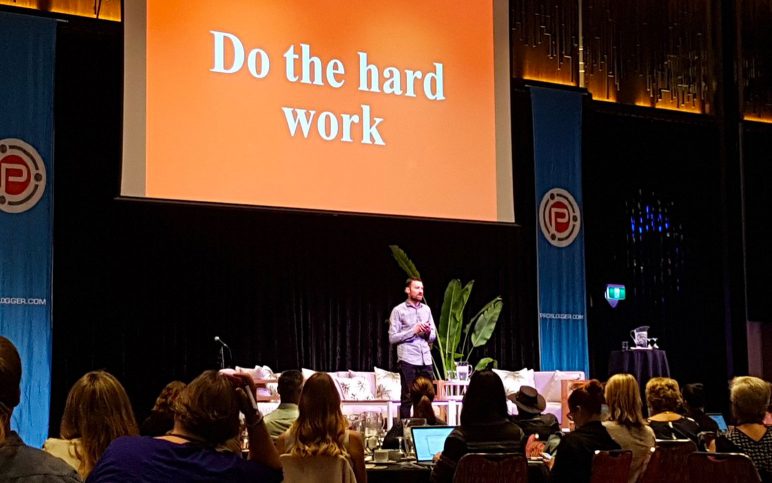
One thing that I did which was extremely challenging was public speaking. The thought of speaking in front of a large group of people terrified me, but people wanted to hear my story so I took on my fear head on. This blog post I wrote on the subject goes into it in more detail.
This resulted in me becoming a speaker at international entrepreneurship events. I’ve spoken at events throughout Australia and traveled internationally delivering speeches for up to 600 people. I’ve recently returned from speaking at the Dynamite Circle event in Bangkok on my experience in building a 6 figure side business by self-publishing books.
The thing I value the most about speaking at events is the real connections you can make with people and the relationships you can foster away from the online vanity metrics. In my early days of public speaking a lady came up to me after I’d spoken and said something like; “Thankyou so much for this talk, you have truly changed my life”. It was a moving and validating moment.
Often the events have been put on by people I look up to and respect. By speaking at them, I’ve been able to become good friend with people like Dan Andrews, James Schramko, Darren Rowse and Chris Ducker and we’ve been able to share audience to some extent.
It’s this type of response and connection which makes me glad I overcame my reluctance for public speaking. But it’s not just about that. It’s about taking every chance you can get to really impact people. There’s no better way than face to face so don’t write it off because it’s hard to scale or because the numbers seem low, or because you are scared. Speaking to 100 people in a room could result in more legitimate connections than writing a post for 10,000 people online.
I turned up on hundreds of podcasts
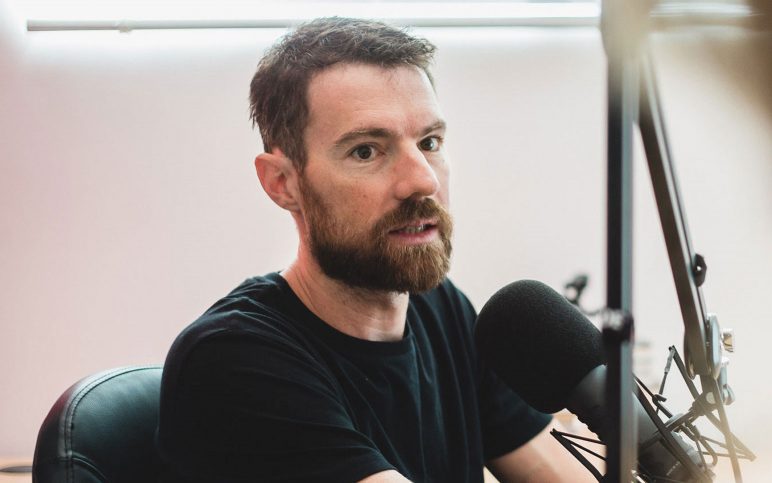
Podcasts are a great way to build your audience. I’ve never looked at them as a way of aggressively promoting myself. Rather if I can share my stories and pass on something valuable or inspirational to others, then mission accomplished.
I’ve also gone out of my way to be generous with my time. From 2012 to 2015 I said yes to almost every podcast I was asked to be on. Some of them never launched, others were so small they went mostly unnoticed. Of course, there were some that did get some attention, such as Startups for the rest of us, Pat Flynn, Mixergy, and TMBA.
And whenever I’ve appeared on a podcast I’ve never asked for anything in return. Which leads me to the subject of…
I was as generous as I possibly could be
The values of generosity are inbuilt into everything I work on. Every opportunity I have, I try to be as generous as possible with my time and my content. I actively reached out to influencers and did everything I could to help them. I became their customer, shared their content, had them on the podcast, linked to them on my blog and added value anywhere I could. But it’s never just been about influencers. I was prolific in forums, helping people out and adding value where I could. I still go into forums and my own Facebook groups and reply to comments most days. I’ve run challenges with 10+ expert speakers requiring my full-time attention for 7 days and didn’t charge a cent. I’ve done thousands of free website reviews.
In the early days people said I was crazy for being so generous with giving away the knowledge in my head and asking for nothing in return. But by going against the general consensus I’ve been able to demonstrate that generosity is not a bad way to go. It’s effective at building trust, it’s also fun and it’s who I am. I enjoy helping people when I can and when you do something that you enjoy, it doesn’t feel like hard work.
I also made myself extremely accessible to my audience from day 1. I always made an effort to read every single email or message and responded to most of them. My mobile number was listed on my site for years until I realized I hate talking on the phone haha. But I’ve made myself accessible in ways that I do like. I’ve built a free Facebook group of close to 10,000 people and on most days I’ll respond and add value to threads where I can help. I read every comment I see on social media and I’m on pretty much every major platform.
These days I have a paid Facebook Mastermind group, but for years I never asked for anything in return for helping people. In fact, I haven’t charged a cent for advice to anyone since I sold my agency in 2012.
I got a lot of press
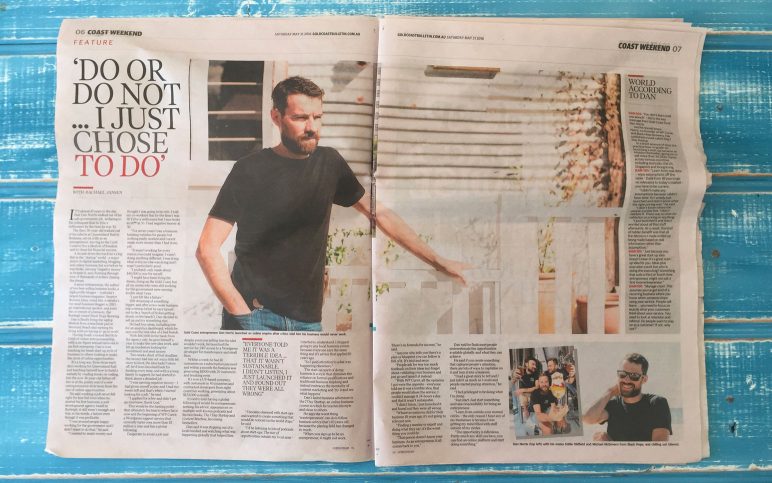
Another positive from being transparent and sharing my stories is the exposure I’ve received from various media outlets. Stories with a human, empathic slant always resonate and translate well, so I’ve never had to chase press coverage too hard to get it.
I’ve been featured in places like Forbes, Inc, Mashable etc and more locally in papers like The Courier Mail and the Gold Coast Bulletin.
Yes it’s a bit of an ego boost to see your name up in lights, but this additional exposure also elevated my credibility and trust and kept my loyal audience numbers steadily growing. If you want to get more press, my number 1 tip is to do something that is press-worthy. Don’t do something that isn’t interesting and try to get people to write about it. That’s not how it works. I will talk about this more in my next article which will be about storytelling in business (click here to get on my email list if you want to get it).
I’ve written 4 best-selling books which have been ordered 55,000+ times

If you have it in you to write a book, you can drastically increase the trust your audience has in you. The fact that I can say I’ve self-published 4 best sellers has taken my credibility to a new level of legitimacy, which has helped me to grow my audience.
If you are creating a lot of content there’s no reason you can’t turn some of it into a book. I like my books to be brands in their own right, something I could potentially build a business around. For example, my first book The 7 Day Startup started out as a blog post series where we launched a new business in 7 days. The concept got traction so I decided to write a book about it. I then turned it into a mastermind group.
I recently wrote an in-depth post on the topic of self-publishing books here.
Again it probably won’t boost your vanity metrics too much but it’s great for trust.
I’ve taken on interesting projects
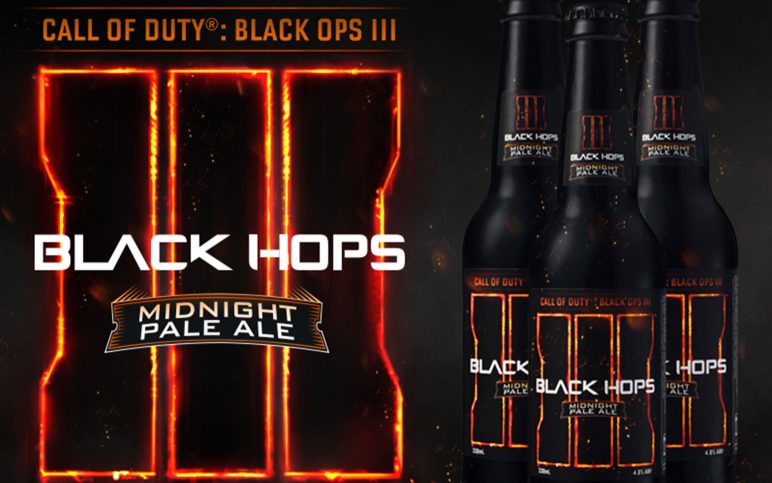
If you want to get people’s attention, do things differently.
I’ve always been keen on taking on projects that help me stand out. I rarely read books and don’t consider myself an author, but that didn’t stop me from self-publishing 4 books.
The entire Black Hops journey has been about taking opportunities and doing things outside the norm. We went from 3 mates brewing homebrew, to actually opening a brewery. Along the way we became the first brewery in Australia to launch via crowdfunding. The traction we got drew us to the attention of games giant Activision, which led to us brewing the world’s first Call of Duty craft beer.
And we’ve talked about all of it via our ongoing blogs and podcasts. We’re the only brewery in Australia with a podcast and I’m pretty sure the only one with a book. Our audience appreciate the transparency and our willingness to embrace new opportunities and challenges. It’s been another key aspect in the growth of my audience across all of my projects.
The more interesting your project, the easier it is to get attention from potential audience members, press outlets, influencers etc. Every online marketing event I go to, all people want to talk about now is the fact I own a brewery. That’s not something every online marketing person can say!
I didn’t blindly take any advice
I try to stay on top of trends but I’ve never blindly taken advice from internet marketers, or anyone for that matter. This is a trap I see way too many people fall into. In my experience, most internet marketers are good at making short term cash from launches, but very few make it out the other side with lasting 7-figure plus businesses (I do continue to follow the ones that do make it out).
At the end of the day, no one understands you and your business better than you. Simply being well known or vocal online is not a mandate for blindly following their advice.
I also haven’t been afraid to be contrarian and do the opposite of what the experts say. When I launched WP Curve as an unlimited monthly service many people said it was a bad idea. But I backed myself in and went against the grain of what many people were telling me. I’ve done the same thing with many projects and many decisions in business and I’ve used it to get a bit more attention than the average person.
Thanks, I hope this post has been useful. If we aren’t friends on Facebook join me here or on Instagram here.
I send an email every week to 15,000+ people, jump on here and get it. I love reading the replies, they give me more ideas for the next post! Also if you have thoughts on this one, feel free to use the comments below.
